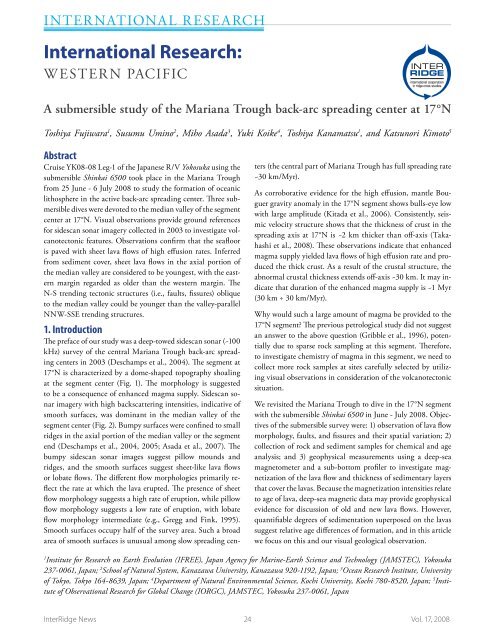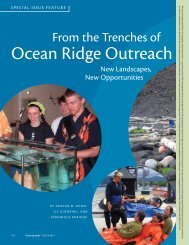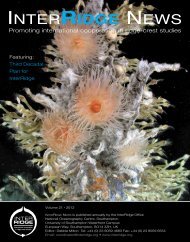Full version, lower resolution, 3.25MB - InterRidge
Full version, lower resolution, 3.25MB - InterRidge
Full version, lower resolution, 3.25MB - InterRidge
Create successful ePaper yourself
Turn your PDF publications into a flip-book with our unique Google optimized e-Paper software.
International Research<br />
International Research:<br />
Western Pacific<br />
A submersible study of the Mariana Trough back-arc spreading center at 17°N<br />
Toshiya Fujiwara 1 , Susumu Umino 2 , Miho Asada 3 , Yuki Koike 4 , Toshiya Kanamatsu 1 , and Katsunori Kimoto 5<br />
Abstract<br />
Cruise YK08-08 Leg-1 of the Japanese R/V Yokosuka using the<br />
submersible Shinkai 6500 took place in the Mariana Trough<br />
from 25 June - 6 July 2008 to study the formation of oceanic<br />
lithosphere in the active back-arc spreading center. Three submersible<br />
dives were devoted to the median valley of the segment<br />
center at 17°N. Visual observations provide ground references<br />
for sidescan sonar imagery collected in 2003 to investigate volcanotectonic<br />
features. Observations confirm that the seafloor<br />
is paved with sheet lava flows of high effusion rates. Inferred<br />
from sediment cover, sheet lava flows in the axial portion of<br />
the median valley are considered to be youngest, with the eastern<br />
margin regarded as older than the western margin. The<br />
N-S trending tectonic structures (i.e., faults, fissures) oblique<br />
to the median valley could be younger than the valley-parallel<br />
NNW-SSE trending structures.<br />
1. Introduction<br />
The preface of our study was a deep-towed sidescan sonar (~100<br />
kHz) survey of the central Mariana Trough back-arc spreading<br />
centers in 2003 (Deschamps et al., 2004). The segment at<br />
17°N is characterized by a dome-shaped topography shoaling<br />
at the segment center (Fig. 1). The morphology is suggested<br />
to be a consequence of enhanced magma supply. Sidescan sonar<br />
imagery with high backscattering intensities, indicative of<br />
smooth surfaces, was dominant in the median valley of the<br />
segment center (Fig. 2). Bumpy surfaces were confined to small<br />
ridges in the axial portion of the median valley or the segment<br />
end (Deschamps et al., 2004, 2005; Asada et al., 2007). The<br />
bumpy sidescan sonar images suggest pillow mounds and<br />
ridges, and the smooth surfaces suggest sheet-like lava flows<br />
or lobate flows. The different flow morphologies primarily reflect<br />
the rate at which the lava erupted. The presence of sheet<br />
flow morphology suggests a high rate of eruption, while pillow<br />
flow morphology suggests a low rate of eruption, with lobate<br />
flow morphology intermediate (e.g., Gregg and Fink, 1995).<br />
Smooth surfaces occupy half of the survey area. Such a broad<br />
area of smooth surfaces is unusual among slow spreading centers<br />
(the central part of Mariana Trough has full spreading rate<br />
~30 km/Myr).<br />
As corroborative evidence for the high effusion, mantle Bouguer<br />
gravity anomaly in the 17°N segment shows bulls-eye low<br />
with large amplitude (Kitada et al., 2006). Consistently, seismic<br />
velocity structure shows that the thickness of crust in the<br />
spreading axis at 17°N is ~2 km thicker than off-axis (Takahashi<br />
et al., 2008). These observations indicate that enhanced<br />
magma supply yielded lava flows of high effusion rate and produced<br />
the thick crust. As a result of the crustal structure, the<br />
abnormal crustal thickness extends off-axis ~30 km. It may indicate<br />
that duration of the enhanced magma supply is ~1 Myr<br />
(30 km ÷ 30 km/Myr).<br />
Why would such a large amount of magma be provided to the<br />
17°N segment? The previous petrological study did not suggest<br />
an answer to the above question (Gribble et al., 1996), potentially<br />
due to sparse rock sampling at this segment. Therefore,<br />
to investigate chemistry of magma in this segment, we need to<br />
collect more rock samples at sites carefully selected by utilizing<br />
visual observations in consideration of the volcanotectonic<br />
situation.<br />
We revisited the Mariana Trough to dive in the 17°N segment<br />
with the submersible Shinkai 6500 in June - July 2008. Objectives<br />
of the submersible survey were: 1) observation of lava flow<br />
morphology, faults, and fissures and their spatial variation; 2)<br />
collection of rock and sediment samples for chemical and age<br />
analysis; and 3) geophysical measurements using a deep-sea<br />
magnetometer and a sub-bottom profiler to investigate magnetization<br />
of the lava flow and thickness of sedimentary layers<br />
that cover the lavas. Because the magnetization intensities relate<br />
to age of lava, deep-sea magnetic data may provide geophysical<br />
evidence for discussion of old and new lava flows. However,<br />
quantifiable degrees of sedimentation superposed on the lavas<br />
suggest relative age differences of formation, and in this article<br />
we focus on this and our visual geological observation.<br />
1<br />
Institute for Research on Earth Evolution (IFREE), Japan Agency for Marine-Earth Science and Technology (JAMSTEC), Yokosuka<br />
237-0061, Japan; 2 School of Natural System, Kanazawa University, Kanazawa 920-1192, Japan; 3 Ocean Research Institute, University<br />
of Tokyo, Tokyo 164-8639, Japan; 4 Department of Natural Environmental Science, Kochi University, Kochi 780-8520, Japan; 5 Institute<br />
of Observational Research for Global Change (IORGC), JAMSTEC, Yokosuka 237-0061, Japan<br />
<strong>InterRidge</strong> News 24 Vol. 17, 2008
















